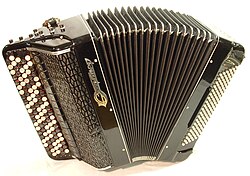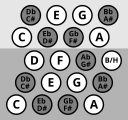 | |
| Classification | Free-reed aerophone |
|---|---|
| Hornbostel–Sachs classification | 412.132 |
| Playing range | |
|
Right-hand manual: The Russian bayan and chromatic button accordions have a much greater right-hand range in scientific pitch notation than accordions with a piano keyboard: five octaves, plus a minor third (written range = E2-G7, actual range = E1-C#8). Left-hand manual | |
| Musicians | |
| List of accordionists | |
| More articles or information | |
| Accordion, Chromatic button accordion, Bayan, Diatonic button accordion, Piano accordion, Stradella bass system, Free-bass system, Accordion reed ranks and switches | |
The bayan (Russian: бая́н, IPA: [bɐˈjan]) is a type of chromatic button accordion developed in the Russian Empire in the early 20th century and named after the 11th-century bard Boyan.
Characteristics


The bayan differs from western chromatic button accordions in some details of construction:
- Reeds are broader and rectangular (rather than trapezoidal).
- Reeds are often attached in large groups to a common plate (rather than in pairs); the plates are screwed to the reed block (rather than attached with wax).
- The melody-side keyboard is attached near the middle of the body (rather than at the rear).
- Reeds are generally not tuned with tremolo.
- Register switches may be operated with the chin on some larger models (also possible with some larger European button accordions).
- The diminished chord row is shifted, so that the diminished G chord is where one would expect the diminished C chord in the Stradella bass system.
- Converter switches that go from standard preset chords to free bass (individual bass notes) are common on the larger instruments. As opposed to Western conventions, in free bass mode the low notes usually are at the bottom of the instrument and the high notes at the top.
- Newer instruments may feature a register where every tone played actually produces a perfect fifth.
The differences in internal construction give the bayan a different tone color from Western instruments, and the bass has a much fuller sound. Because of their range and purity of tone, bayans are often the instrument of choice for accordion virtuosi who perform classical and contemporary classical music. Two Soviet composers of note who wrote compositions for bayan are Vladislav Zolotaryov and Sofia Gubaidulina. Slovak composer Peter Machajdík composed Concerto for two Bayans and Orchestra, which was premiered by Acco Duo (Miran Vaupotić & Ivana Levak-Vaupotić), with the Symphony Orchestra of the Pomeranian Philharmonic under Alexander Gref, at the Paderewski Philharmonic in Bydgoszcz, Poland on 4 June 2009. Russian Bayan virtuoso Stas Venglevski has premiered contemporary works by Yehuda Yannay, Anthony Galla-Rini and William Susman.
See also
References
- Llanos, Ricardo; Alberdi, Inaki (2002). "Accordion for Composers (Spanish publication)". pp. 2–5. Retrieved 20 October 2022.
- "Bayan - Russian button accordion - баян". Barynya.com. Archived from the original on 17 December 2017. Retrieved 28 January 2017.
- "PETER MACHAJDÍK: CONCERTO FOR TWO BAYANS AND ORCHESTRA". www.machajdik.com. Retrieved 20 October 2022.
- ""Premiere performances by Stas Venglevski"" (PDF). Archived from the original (PDF) on March 12, 2011. Retrieved March 12, 2010.
Sources
- Cherkaskyi, L. Ukrainski narodni muzychni instrumenty. Tekhnika, Kyiv, Ukraine, 2003. 262 pages. ISBN 978-966-575-111-3.
External links
| Russian musical instruments | |
|---|---|
| Percussion | |
| String | |
| Wind | |
| Squeezeboxes | |||||||
|---|---|---|---|---|---|---|---|
| Accordions |
| ||||||
| Concertinas | |||||||
| Russian handicrafts | |
|---|---|
| Decorative arts | |
| Tableware | |
| Clothing | |
| Musical instruments | |
| Toys | |
| Other | |